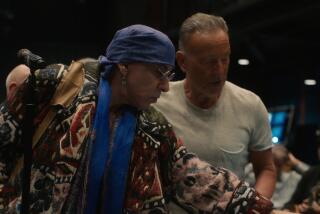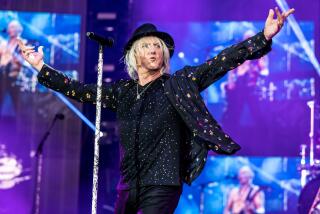Yee-o! Post-50 Police
Vancouver, Canada —
ALL fans had to do to feel absolutely fantastic about the Police reunion tour, which began Monday at General Motors Place, was to keep their eyes on drummer Stewart Copeland.
Wearing a very new wave red-and-black bicycle shirt and sporty headband, hopping like a leprechaun between an imposing percussion setup and an equally sizable drum kit, the 54-year-old bard of rocking polyrhythms couldn’t stop grinning. Sometimes, as Copeland kept the pulse going while guitarist Andy Summers bent chords in all directions and bassist/rock god Sting tinkered with his vocal phrasing, the grin turned toward a grimace. But rarely do players exhibit this much glee during a two-hour arena rock show, especially one marked by unremitting singalong choruses of “yee-o!” and enough elegant meandering to suggest that Sting had won some battles in rehearsal.
Copeland had good reason to be happy. Though not flawless, the Police’s two-hour return to the arena stage amply demonstrated what made the band such a force in pop two decades ago. It’s something surprisingly rare in hugely successful bands: risk-taking interplay that stresses the subtleties in songs as well as the hooks, among players different enough to spar but smart enough to prioritize the groove.
At the turn of the 1980s, this wasn’t as common as it should have been, considering the stealth influence of reggae, funk and even disco on new wave, the loose subgenre the Police spearheaded. Only a few groups beyond the post-punk underground -- notably the Talking Heads, may they reunite someday! -- could generate as much dance floor fun as the famously blond trio, whose tour reaches the Southland next month. In a long set that bopped from hit to hit to hit, starting with “Message in a Bottle” and ending with a cheerfully frenzied “Next to You,” from the band’s 1978 debut, “Outlandos d’Amour,” the three musicians chased one another’s leads and finished one another’s musical sentences, providing more than enough stimulus to make up for a near-complete absence of crowd-pleasing spectacle.
The music was the spectacle. Sting’s glamour (now enhanced by what must be a Madonna-esque workout regime, whose benefits he displayed in a taut white tank and yoga-friendly black stretch pants) and his flowery but often sinister lyrics about love and obsession defined the Police’s pop identity. But without his nimble bass playing and singing, Copeland’s breakneck inventiveness on percussion and Summers’ subtly cocky way of filling space with effects and syncopation, the band would have been merely hit makers, not genre leaders.
Caribbean cool was mixed with a very British surliness and a prog rocker’s love of twists and turns to form the basis of the Police palette. Over the years, another characteristic emerged: Police music somehow seemed fast and slow, intense and spacious. “Roxanne,” the group’s first hit and, judging by the crowd’s reaction at GM Place, still its biggest, set the mold with its syrupy verses and jittery chorus. Many variations followed as the trio worked on the intricate rhythms and tonalities that lent Police hits their intricate aura.
At GM Place, the band reached for that complexity again and hit it more often than not. The staging was spare, with only a few flashing lights and video images filling in for the dancers, props and signage that fluff up most contemporary arena shows. Perhaps it’s vainglorious for the Police to think that its playing is exciting enough, but it’s also correct. “Synchronicity II” was six minutes of zigzagging guitar and fuming vocals pushed forward by Copeland’s stick on the snare. “The Bed’s Too Big Without You” and “Roxanne” turned reggae’s dislocated lilt into the sound of romantic anxiety. “Every Breath You Take,” with its lovely melody and upsetting lyrics about sexual thrall, showed how the band uses prettiness as a trick to get across some transgressively nasty sentiments.
Most songs extended beyond the original versions, allowing everyone to stretch and show off. But this approach occasionally backfired. Sting’s highly successful post-Police career has favored smooth, jazzy forays into adult contemporary pop, and this sensibility sneaked into the arrangements, making “Invisible Sun” unbearably mellow (despite a stark video somehow about the Middle East crisis) and “Walking on the Moon” simply boring. That song also fell victim to Sting’s penchant for the Harry Belafonte-esque refrain “yee-o,” which made for far too much audience call and response.
Such missteps and detours may be why it took fans almost an hour to really start dancing, though they ardently cheered from the set’s first note. The Police is not a band that should dawdle. Yet Summers sometimes drifted into private dialogue with his effects pedals, and Sting made some strange vocal choices -- he was too stingy with his falsetto and laid back when he could have pushed harder. Fastest songs came off best, requiring the trio to put individual interests aside and lock in.
As for the limitations wrought by age, they were limited to the occasional glitch in Sting’s upper register. A few songs were slowed down, maybe to encourage those jazzy jams or maybe just because Sting likes to take his time. If that’s the reason, Sting should reconsider his strategy. After many years of playing the field, he’s finally back with the guys who can really kick his carefully toned backside. Especially that drummer. And he’s delighted to have the chance.
*
The Police
Where: Staples Center, 1111 S. Figueroa St., Los Angeles
When: 7:30 p.m. June 20
Price: $52 to $260
Contact: (213) 742-7340
Also
Where: Honda Center, 2695 E. Katella Ave., Anaheim
When: 7:30 p.m. June 21
Price: $50 to $250
Contact: (714) 704-2500
Also
Where: Dodger Stadium, Los Angeles
When: 6:30 p.m. June 23
Price: $50 to $250
Contact: (866) 363-4377
More to Read
The biggest entertainment stories
Get our big stories about Hollywood, film, television, music, arts, culture and more right in your inbox as soon as they publish.
You may occasionally receive promotional content from the Los Angeles Times.










